Ames W.F., Harrel E.M., Herod J.V. (editors). Differential Equations with Applications to Mathematical Physics
Подождите немного. Документ загружается.

This page intentionally left blank

Spectral Deformations and
Soliton Equations
F.
Gesztesy
Department
of
Mathematics
University
of
Missouri, Columbia,
MO
65211,
USA
R.
Weikard
Department
of
Mathematics
University
of
Alabama at Birmingham, Birmingham,
AL
35294,
USA
1
Introduction
The main purpose of this paper is to describe the construction of new
solutions
V
of the Korteweg-deVries (KdV) hierarchy of equations by
deformations of
a
given finite-gap solution
VO.
In order to describe
the nature
of
these deformations we assume for
a
moment that the
given real-valued quasi-periodic finite-gap solution
VO
is
described
in terms
of the Its-Matveev formula
[34]
(see, e.g.,
(3.43)).
The basic
ingredients underlying this formula are
a
compact hyperelliptic curve
Kn
of
genus
IZ,
m=O
and an associated Diriclilet divisor
Differential Equations
with
Copyright
@
1993
by Academic Press, Inc.
Applications to Mathematical
All
rights
of
repmduction
in
any
form
reserved.
Physics
ISBN
0-12-056740-7
101
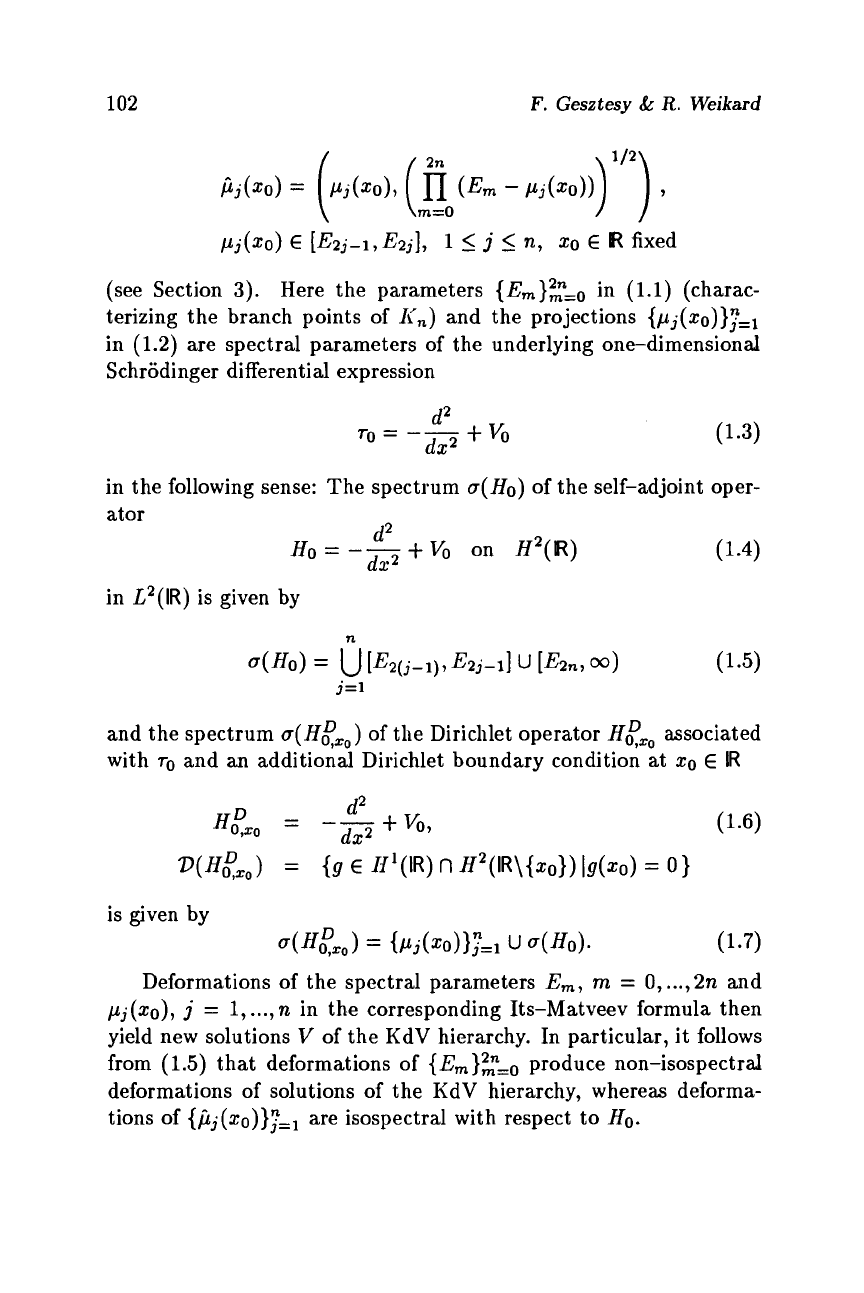
102
F.
Gesztesy
&
R.
Weikard
(see Section
3).
Here the parameters
{Em}z=o
in
(1.1)
(charac-
terizing the branch points
of
Kn)
and the projections
{pj(x~)}jn,~
in
(1.2)
are spectral parameters of the underlying one-dimensional
Schrodinger differential expression
d2
To
=
--
+
v,
dx2
in the following sense: The spectrum
a(&)
of the self-adjoint oper-
ator
d2
dx2
HO
=
--
+
VO
on
H~(R)
(1.4)
in
.L2(IR)
is given by
and the spectrum
a(H&,)
of the Diriclilet operator
H&,
associated
with
TO
and
an
additional Dirichlet boundary condition at
xo
E
IR
is given by
.w:,,)
=
{Pj(XO)}jn=l
u
4Ho).
(1.7)
Deformations of the spectral parameters
Em,
m
=
0,
...,
2n
and
pj(xo),
j
=
1,
...,
n
in the corresponding Its-Matveev formula then
yield new solutions
V
of the KdV hierarchy. In particular, it follows
from
(1.5)
that deformations of produce non-isospectral
deformations of solutions of the KdV hierarchy, whereas deforma-
tions of
{jij(~O)}jn=~
are isospectral with respect to
Ho.
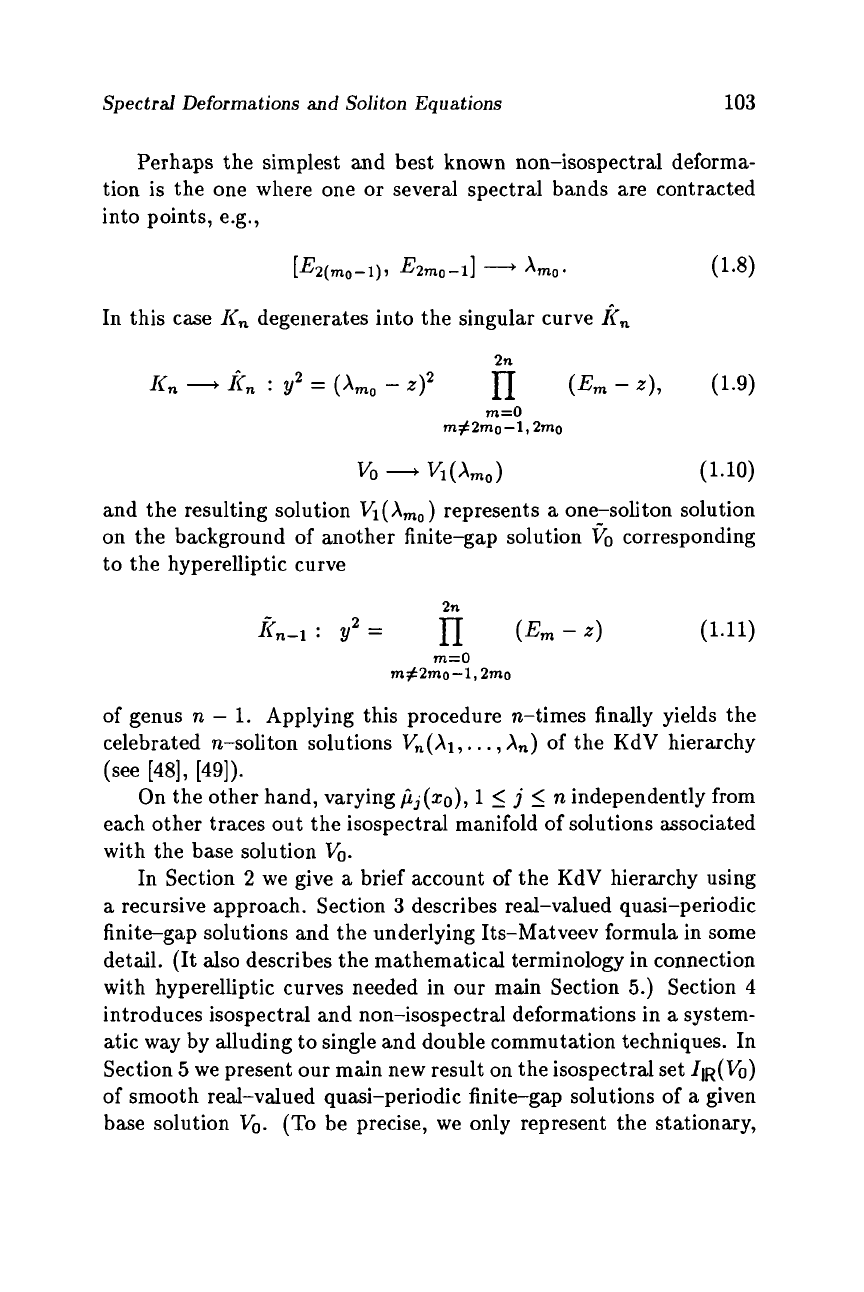
Spectral Deformations
and
Soliton Equations
103
Perhaps the simplest and best known non-isospectral deforma-
tion is the one where one
or
several spectral bands are contracted
into points, e.g.,
In this case
Kn
degenerates into the singular curve
I?,,
2n
I<,
-
fin
:
y2
=
(~m~
-
n
(Em
-
z),
(1.9)
VO
-
Vl(Xrn0)
(1.10)
m=O
m#2mo-l,2rno
and the resulting solution
V1(Xmo)
represents
a
one-soliton solution
on the background of another finite-gap solution
VO
corresponding
to the hyperelliptic curve
2n
Rn-1
:
y2
=
n
(Ern-4
(1.11)
m=O
m#2rno-l,2rno
of genus n
-
1.
Applying this procedure n-times finally yields the
celebrated n-soliton solutions
V,(Xl,.
. .
,An)
of the KdV hierarchy
On the other hand, varying
bj(zo),
1
5
j
5
n independently from
each other traces out the isospectral manifold of solutions associated
with the base solution
Vi.
In Section
2
we give
a
brief account of the KdV hierarchy using
a
recursive approach. Section
3
describes real-valued quasi-periodic
finite-gap solutions and the underlying Its-Matveev formula in some
detail. (It
also
describes the mathematical terminology in connection
with hyperelliptic curves needed in
our
main Section
5.)
Section 4
introduces isospectral and non-isospectral deformations in
a
system-
atic way by alluding to single and double commutation techniques. In
Section
5
we present our main new result on the isospectral set
IIR(VO)
of smooth real-valued quasi-periodic finite-gap solutions of
a
given
base solution
Vo.
(To
be precise, we only represent the stationary,
(see
[48l,
W1).

104
F.
Gesztesy
&
R.
Weikard
i.e., time-independent case since the insertion
of
the proper time-
dependence poses no difficulties.) Finally, in Section
6
we sketch
some generalizations and open problems in connection with infinite
gap solutions and consider the limit
of
N-soliton solutions
as
N
-,
00
in some detail.
Throughout this paper we confine ourselves to the KdV hierarchy.
However, our methods extend to other
1
+
1-dimensional completely
integrable nonlinear evolution equations and to higher-dimensional
systems such as the
KP
hierarchy.
Work
on these extensions is in
progress and will appear elsewhere.
2
The
KdV
Hierarchy
In order to describe the hierarchy
of
I<dV equations we first recall
the recursive approach to the underlying Lax pairs (see, e.g.,
[3], [44],
[46]
for
details). Consider the differential expressions
d2
dx
W)
=
-2
+
V(x,t),
where the
{jj}y=o
satisfy the recursion relation
fo
=
1, (2.2)
Define also
jn+l
by
Then one can show that
[i)zn+l,
4
=
2L+l,z, (2.4)
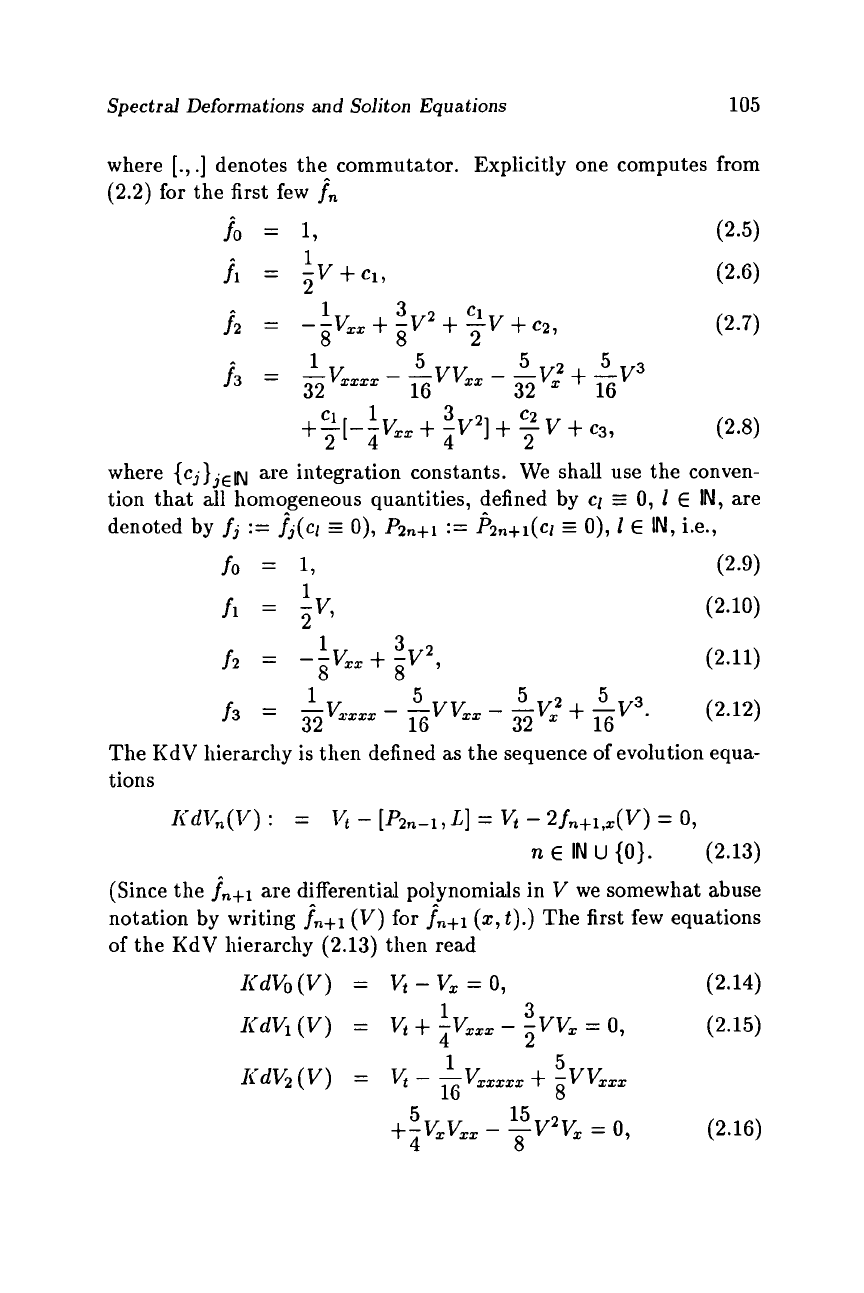
Spectral Deformations and Soliton Equations
105
where
[.,
.]
denotes the commutator. Explicitly one computes from
(2.2)
for the first few
fn
fo
=
fl
=
f2
=
f3
=
1,
-v
+
c1,
1
2
1
3
C1
8 8
2
--vxx
+
-v2
+
-v
+
c2,
-vxxxx
-
-vvxx
-
-v,2
+
-v3
+-[--vxx
+
-V2]
+
-
v
+
c3,
1
5
5
5
32 16 32 16
Cl
1
3
c2
24
4
2
where
{C~}~~W
are integration constants. We shall use the conven-
tion that all homogeneous quantities, defined by
cl
E
0,
1
E
IN,
are
denoted by
fj
:=
fj(C1
0),
Pzn+1
:=
P2n+l(~l
0),
1
E
IN,
i.e.,
fo
=
1,
(2.9)
1
fl
=
-v,
2 (2.10)
(2.11)
1
3
8 8
f2
=
--v,,
+
-v2,
1
5
5 5
f3
=
-vv,,x,
32
-
-vvxx
16
-
-v;
32
+
-v3.
16 (2.12)
The KdV hierarchy is then defined as the sequence of evolution equa-
tions
IidI/,(V)
:
=
IG
-
[&-I,
L]
=
&
-
2
fn+l,x(v)
=
0,
n
E
IN
U
(0).
(2.13)
(Since the
fn+l
are differential polynomials in
V
we somewhat abuse
notation by writing
jn+l
(V)
for
fn+1
(z,
t).)
The first few equations
of the KdV hierarchy
(2.13)
then read
IidVo(V)
=
IidVl(V)
=
IidV2(V)
=
vt
-
v,
=
0,
(2.14)
1
3
vt
+
,vxxx
-
-vvx
2
=
0,
(2.15)
1
5
vt
-
--xxxxx
+
-vvxxx
16
8
+-v v
-
-v2vx
8
=
0,
(2.16)
5
15
4
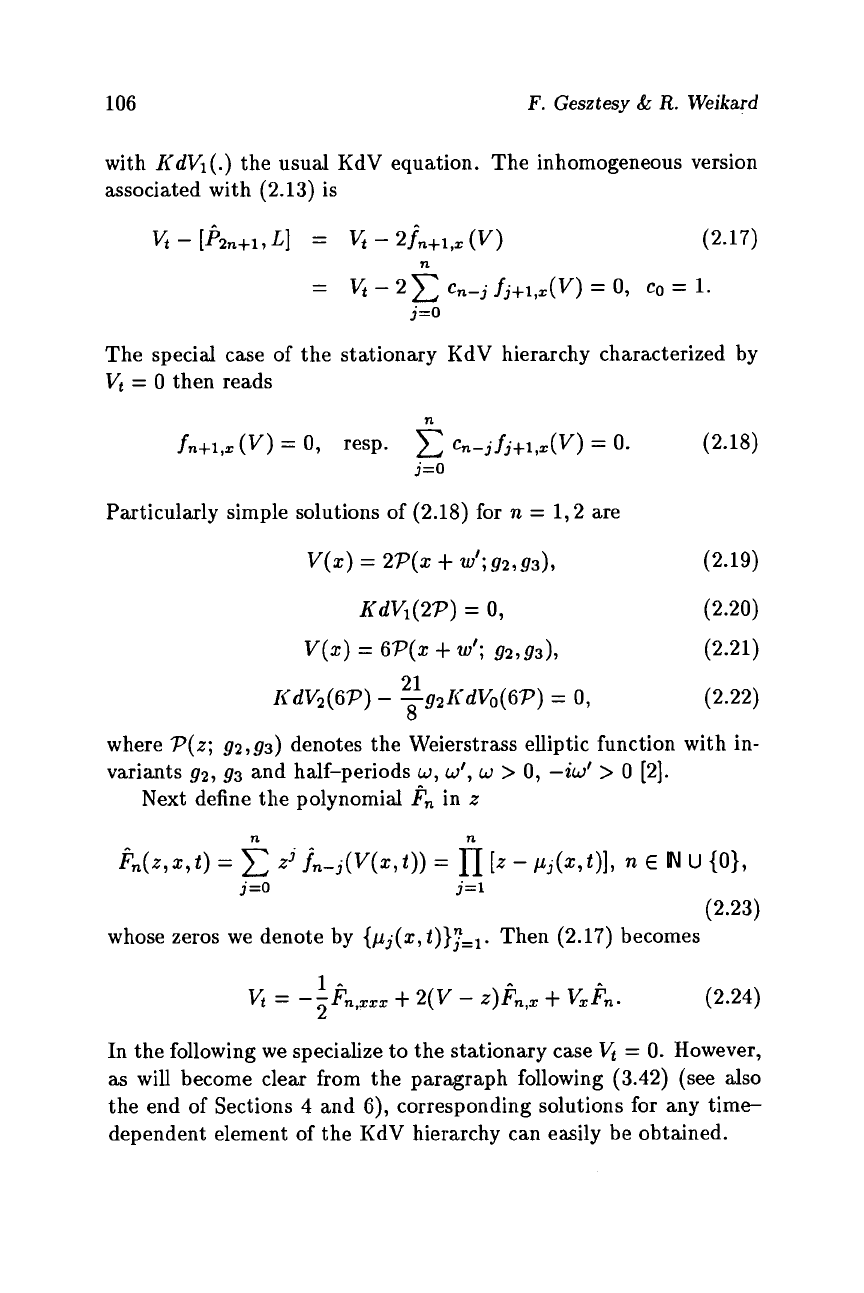
106
F.
Gesztesy
&
R.
Weikard
with
KdVl(.)
the usual KdV equation. The inhomogeneous version
associated with
(2.13)
is
vt
-
[?2n+l,
~1
=
vt
-
2.fn+1,z (v) (2.17)
n
-
-
V,
-
2
C
cn-j fj+l,Z(V)
=
0,
CO
=
1.
j=O
The special case of the stationary KdV hierarchy characterized by
V,
=
0
then reads
Particularly simple solutions of
(2.18)
for
n
=
1,2
are
(2.22)
21
8
KdV2(SP)
-
-g2#dVo(GP)
=
0,
where
P(z;
g2,93)
denotes the Weierstrass elliptic function with in-
variants
g2, g3
and half-periods
w,
w',
w
>
0,
-iw'
>
0
[2].
Next define the polynomial
Fn
in
z
n
n
&(z,z,t)
=
C
2'
.fn-j(V(z,t))
=
n
[Z
-
~j(z,t)],
n
E
M
u
(01,
j=O
j=1
(2.23)
whose zeros we denote by
{pj(~,t)}?=~.
Then
(2.17)
becomes
(2.24)
In the following we specialize to the stationary case
=
0.
However,
as will become clear from the paragraph following
(3.42)
(see
also
the end of Sections
4
and
G),
corresponding solutions for any time-
dependent element of the KdV hierarchy can easily be obtained.
1-
2
vt
=
--Fn,zzz
+
2(v
-
z)kn,z
+
Kin-
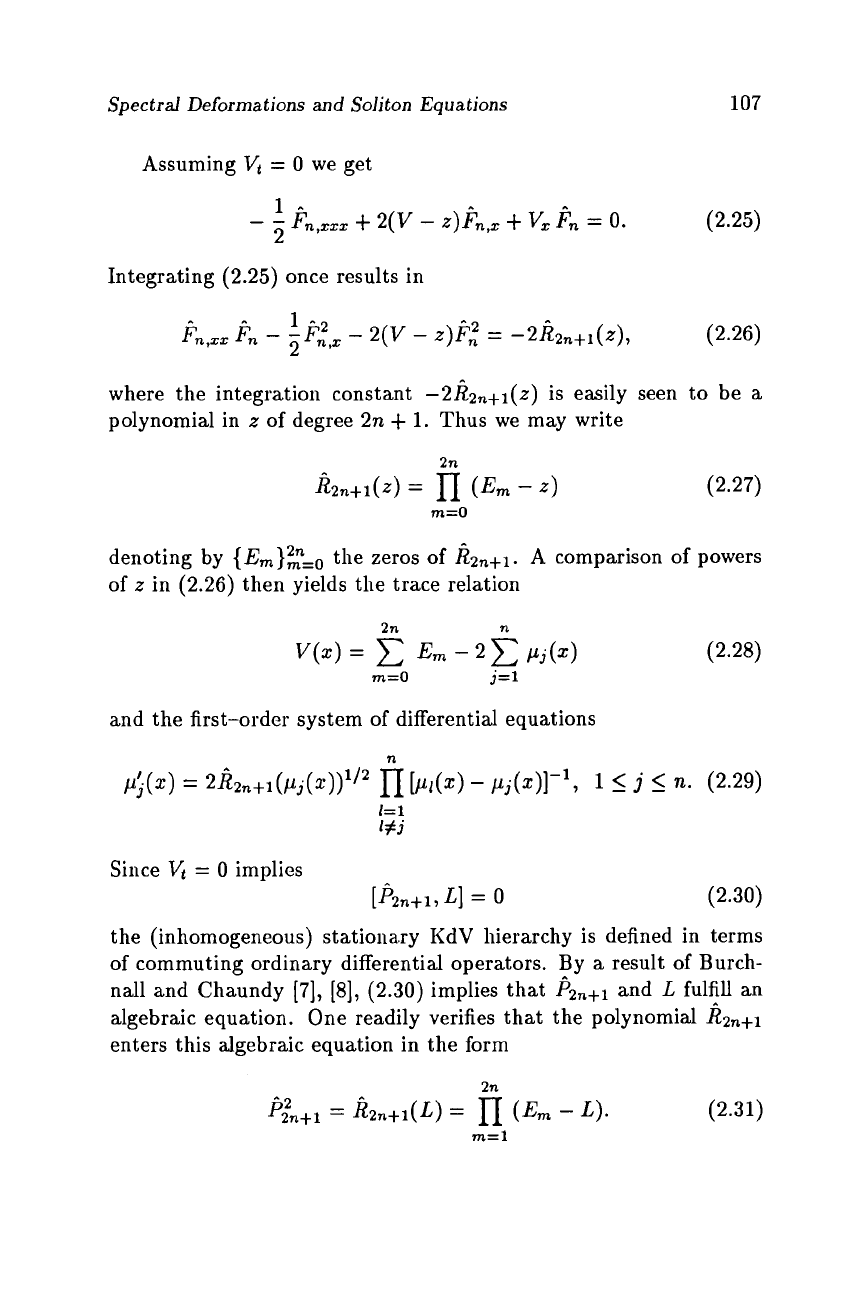
Spectral Deformations
and
Soliton Equations
107
Assuming
Vt
=
0
we get
Integrating
(2.25)
once results in
where the integration constant
-2&n+1(z)
is easily seen to be
a
polynomial in
z
of degree
272
+
1.
Thus we may write
denoting by
{Em}$=o
the zeros of
&n+l.
A comparison of powers
of
z
in
(2.26)
then yields the trace relation
2n
n
and the first-order system of differential equations
(2.30)
the (inhomogeneous) statioimry KdV hierarchy is defined in terms
of commuting ordinary differential operators. By
a
result
of
Burch-
nall and Chaundy
[7], [8], (2.30)
implies that and
L
fulfill an
algebraic equation. One readily verifies that the polynomial
k2n+1
enters this algebraic equation in the form
m=l

108
F.
Gesztesy
&
R.
Weikard
Hence one is led to hyperelliptic curves
in
a
natural way. Returning to our simple examples
(??)-(??),
one
computes
for
n=l:
(an elliptic curve), and
for
n=2:
v(z)
=
Gp(X
+
u';
92793)~
(2.35)
(2.36)
21
8
P5
=
P5
-
-g2P*,
3
Finite-Gap Potentials, Its-Matveev
Formula
Any
V
satisfying
a
stationary higher order KdV equation
of
the type
will be called
a
(stationary) finite-gap potential. In order to explain
this terminology we make the following two hypotheses:
(H.3.1)
V
E
C"(IR)
is real-valued.
(H.3.2)
Eo
<
El
<
**.
<
Ezn.
In particular, (H.3.2) implies simple zeros
of
&2n+l
and hence
yields
a
nonsingular hyperelliptic curve
(??).
In addition one can
show that (3.1) together with (H.3.1) and (H.3.2) imply quasi-perio-
dicity and hence boundedness
of
V
(see (3.36)). Hypotheses (H.3.1)
and (H.3.2) will be assumed throughout the end
of
Section
5.
More-
over, the one-dimensional Schrodinger operator
H
in
L2(
IR)
defined
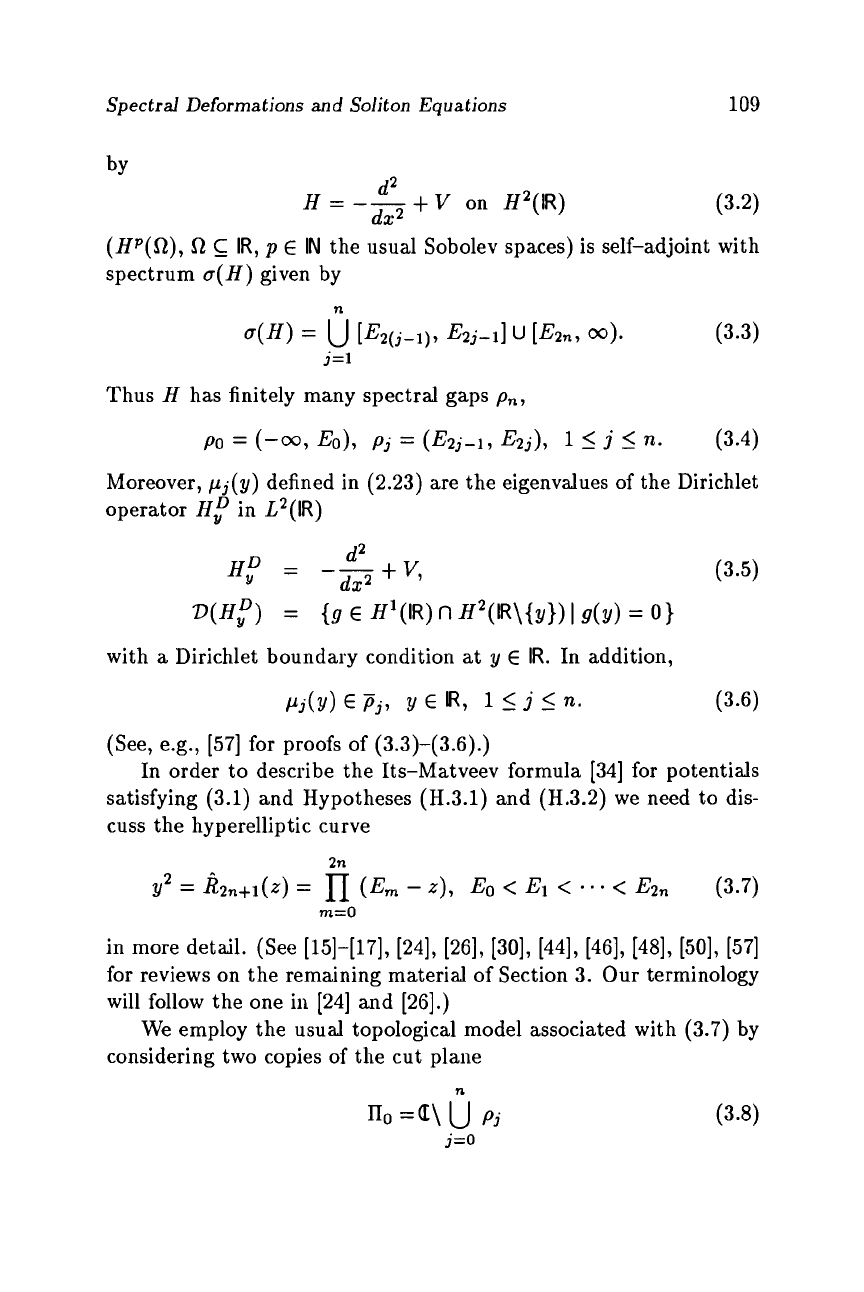
Spectral Deformations and Soliton Equations
109
by
(3.2)
d2
dx2
H
=
--
+
V
on H2(IR)
(Hp(R),
R
S
IR,
p
E
IN
the usual Sobolev spaces) is self-adjoint with
spectrum
a(H)
given by
n
~(EI)
=
U
[~(j-l),
~2j-11
u
[~2n,
(3.3)
j=1
Thus
I1
has finitely many spectral gaps pn,
PO
=
(-00,
Eo),
Pj
=
(E2j-1, &j),
1
I
.i
I
TI,.
(3.4)
Moreover, /ij(y) defined in
(2.23)
are the eigenvalues of the Dirichlet
operator
H/
in L2(IR)
with
a
Dirichlet boundary condition at
y
E
IR.
In addition,
P.~(Y)
E
Pj,
Y
E
R,
1
I
.i
I
(3.6)
(See, e.g.,
[57]
for proofs of
(3.3)-(3.6).)
In order to describe the Its-Matveev formula
[34]
for potentials
satisfying
(3.1)
and Hypotheses (H.3.1) and
(H.3.2)
we need to dis-
cuss the hyperelliptic curve
2n
y2
=
h2n+l(~)
=
IT
(Em
-
z),
EO
<
~1
<
*
*
*
<
~2n
(3.7)
m=O
in more detail. (See
[15]-[17], [24], [26], [30], [44], [46], [48], [50], [57]
for reviews on the remaining material of Section
3. Our
terminology
will follow the one in
[24]
and
[2G].)
We employ the usual topological model associated with
(3.7)
by
considering two copies of the cut plane
n
no
=a\
U
pj
j=O
